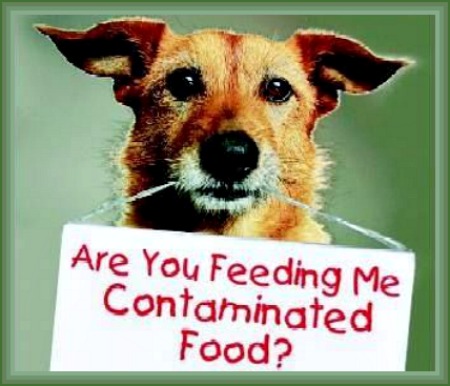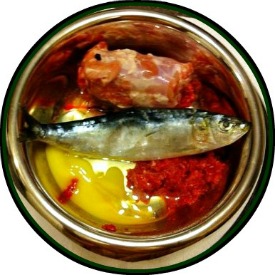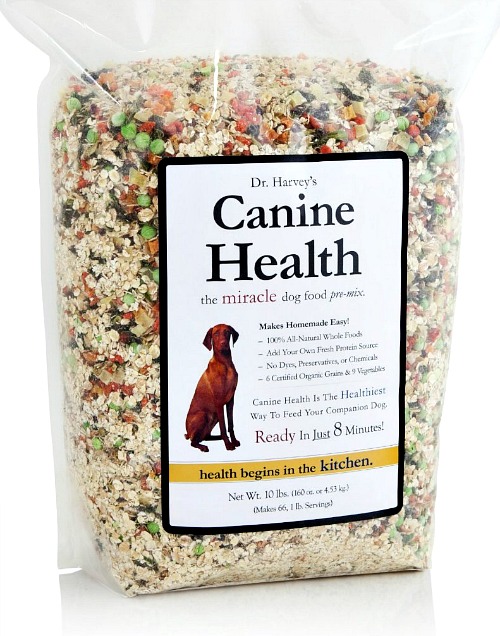Stop Buying Poisoned Dog Food

Are You Buying Poisoned Dog Food?
Have you ever scanned the ingredients in a commercial dog food and thought, "What the hell is this? It can't be healthy. I can't even pronounce it."
Unfortunately, if your dog eats ordinary, processed dog food, your dog probably eats things that are a whole lot worse than what you might have found him chewing on in your neighbors backyard yesterday. Be warned. Your dog is eating poisoned dog food without you even realizing it.
Most commercial dog foods available in stores today are so highly processed and full of preservatives and chemicals, that they aren't any better for our dogs than Twinkies (TM) are for humans. And the bad thing is our government who is supposed to be regulating it, isn't doing their job.

Commercial Dog Food Ingredients
Commercial, processed dog food contain cheap ingredients, unhealthy fillers, unhealthy preservatives or poisonous chemicals.
Many dog foods advertised as "preservative-free" do, in fact, contain preservatives. Manufacturers don't have to list preservatives that they themselves did not add.
Many preservatives make their way into dog food at rendering plants before the meat is even sent to the manufacturer. An analysis of several dog foods labeled "chemical free" or "all natural ingredients" found synthetic antioxidants in all samples.
Although you won't see it on the label, since it is often added at the rendering plant and not by the manufacturer, ethoxyquin (EQ) is used to preserve most dry dog food. EQ is the most powerful of all preservatives and may be the most toxic.
Rendering plant workers that have been exposed to it denoted side effects similar to those of Agent Orange:
* A dramatic rise in liver or kidney damage
* Cancerous skin lesions
* Hair loss
* Blindness
* Leukemia
* Fetal abnormalities
* Chronic diarrhea
In animals, EQ has been linked to:
* Immune deficiency syndrome
* Spleen, stomach, and liver cancers
* And a host of allergies
The New York State Food Laboratory reported that it found aminopterin in food from the palatability studies. Director Daniel Rice has stated that aminopterin was a cancer drug that was used about 50 years ago in the United States. The Environmental Protection Agency later banned use of the toxin as a rodenticide in this country.
The "animal" or "meat by-products", that are often the first or second ingredient listed on your commercial dog food packages, are biodegradable wastes that we would never want to eat ourselves.
These are parts that Americans rarely consume as they are not intended for human consumption. These parts come from animal carcasses, and include, but are not limited to, animal heads, organs, lungs, bones, blood, skin, hooves, hair, partially defatted low temperature fatty tissue, stomachs, intestines and feces.

Where Do They Get The Animal and Meat By-Products?
The origins of these "animal" by-products and so called "meat" by-products include catering waste (all waste food from restaurants, catering facilities, central kitchens, slaughterhouses and household kitchens). It might also contain parts from sick or dying animals that can come from slaughterhouses or euthanized animals from animal shelters. (This photo is showing euthanized dogs about to be processed into commercial dog food).
The city of Los Angeles alone, for example, sends some two hundred tons of euthanized cats and dogs to a dog food plant every month.
The worst is that dog food companies don't stop with pets. Your dog is also consuming euthanized animals from zoos, animal control and putrid, decaying road kill.
Before these animal parts and euthanized animals are shipped to the rendering plant, they are "denatured." This means that crude carbolic acid, cresylic disinfectant, or citronella, is sprayed on the product.
The true horror is the drug used to kill these stray and abandoned animals, Sodium Pentobarbital, is not broken down by the manufacturing process and is still present in active form in your dog's food!!
Before these poisoned animal parts can be used to make your poisoned dog food, they are taken to the rendering plants where they are ground into the meat by-products and are then shipped as meal to dog food processors.

The Manufacturing Plants
Next, the manufacturers combine the meal with carbohydrates such as corn, thickeners like guar gum, vitamins, minerals, food coloring and preservatives.
By the way, dogs are color blind and don't care what color their dog food is. The food coloring that is added to their food, is there to appeal to the human eye, not the dogs.
To make wet food, this grotesque glop is then heated in a pressure cooker and canned or sealed in a pouch.
For dry pellets, all of these dead animals, and other ghastly materials, are then processed until the portion left over for dog food production is a brown powder, which consists of 25% fecal matter! The stuff is then heated, cut into tiny pieces, dried, and then wrapped for shipment.
The high end brands tend to have fixed formulas, while cheaper brands often change recipes to include ingredients that happen to be selling cheap at the time of processing. (They might decide to replace corn with wheat, for example, if wheat prices are especially low.) However, I did say "tend to have", as some of the higher end, so called premiums foods are not any better, nutritionally, than some of the least expensive generic dog food.

What Kind of Dog Food Should You Feed Your Dog?
So many people have dogs for pets without knowing what they should be feeding their dogs or what the proper care for their dogs are.
They take the easy route of buying the cheapest dog food that they can find and when it's time to feed their pet, they just open a can or two, dump it into the dogs bowl and they are done.
Most dogs will eat just about anything especially when they are hungry and are not finicky eaters like some cats can be.
They can't tell you that by taking the quick and easy route, you are the one causing your pet allergies, or perhaps your pets hair will start falling out or he will develop lesions on his skin, or he has problems with his bowel movements or his urinary track.
Quick and easy isn't always best. I know how difficult it can be in our busy lives to find the time to make nutritional meals for our pets, but that really isn't the issue.
Keeping our family pets healthy is the issue. and if it means taking an extra 30 minutes to prepare nutritious food for our pets we should be adapting and working it into our busy schedules.
Another problem is that most humans don't have a clue as to what their dogs need to eat for optimum health.
Click this link to another of my HubPages to get the answer to, "What is a Healthy Dog Diet?" I created this page to educate people on the nutritional needs of their dogs and what foods their dogs should not be eating. Read the information so that you will be better equipped to make healthier choices for your beloved 4-legged family member.

Dr. Harvey's Organic Dog Food
This is an example of an organic healthy dog food grain and vegetable supplement intended to mix in with raw or cooked meat protein for dogs.
I think this is one solution for fixing a healthier dog food at home, but remember they still need fresh raw food too!
Dr. Harvey's pre-mix dog food is made with the highest quality organic, all-natural, holistic ingredients, including 6 certified organic grains, 9 vegetables and 14 herbs.
Federal Law Rulings On Dog Food Inspections In The United States
Federal law does not mandate the frequency of inspections or premarket approval of foods under FDA jurisdiction, unlike the meat and egg products under the jurisdiction of the Department of Agriculture. The FDA regulates much more of the food supply with much less money than the USDA, according to the Government Accountability Office.
Dr. Stephen Sundlof, director of the FDA Center for Veterinary Medicine, stated that regulation of human and animal food doesn't differ substantially.
The Food, Drug, and Cosmetic Act requires that foods be pure and wholesome and that they contain no harmful or deleterious substances, all though the act does not specify how manufacturers should ensure safety.
The agency has limited resources for inspecting animal food and drugs, so it focuses inspections on manufacturers of drugs and of feed for food-producing animals, not for dog food.
Usually an inspection is only conducted when there has been a complaint, such as the recent dog food poisoning of the suspected batch of wheat gluten from China.

Tips For Dog Food Safety
* Don't assume that your dog should eat what humans eat.
* "People food" such as chocolate, grapes, raisins, apple seeds & pear seeds, onions and onion powder can be either difficult for your dog to digest or toxic to his system.
* Macadamia nuts, coffee and salt are other human foods that should not should not be fed.
* Check with your veterinarian to be sure that the table scraps you are feeding your dog are on the safe list.
* There are only 9 packaged dog foods, in my opinion, that are truly safe and healthy for your dog and IAMS dog food is not one of them. IAMS is one of the worst, yet they demand a premium price. They pay a premium price for their advertising too.
* If you want to quit feeding your pooch poisoned dog food, learn to make your own at home and to incorporate raw food into their diet.



